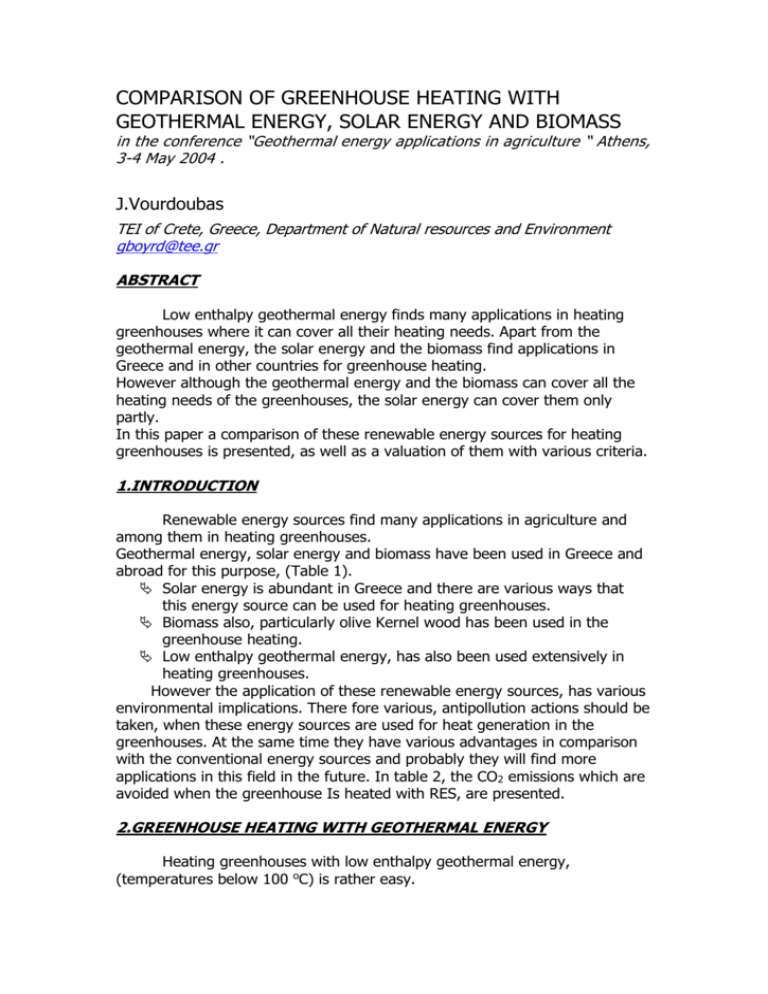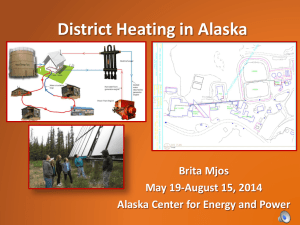COMPARISON OF GREENHOUSE HEATING WITH GEOTHERMAL
advertisement

COMPARISON OF GREENHOUSE HEATING WITH GEOTHERMAL ENERGY, SOLAR ENERGY AND BIOMASS in the conference “Geothermal energy applications in agriculture “ Athens, 3-4 May 2004 . J.Vourdoubas TEI of Crete, Greece, Department of Natural resources and Environment gboyrd@tee.gr ABSTRACT Low enthalpy geothermal energy finds many applications in heating greenhouses where it can cover all their heating needs. Apart from the geothermal energy, the solar energy and the biomass find applications in Greece and in other countries for greenhouse heating. However although the geothermal energy and the biomass can cover all the heating needs of the greenhouses, the solar energy can cover them only partly. In this paper a comparison of these renewable energy sources for heating greenhouses is presented, as well as a valuation of them with various criteria. 1.INTRODUCTION Renewable energy sources find many applications in agriculture and among them in heating greenhouses. Geothermal energy, solar energy and biomass have been used in Greece and abroad for this purpose, (Table 1). Solar energy is abundant in Greece and there are various ways that this energy source can be used for heating greenhouses. Biomass also, particularly olive Kernel wood has been used in the greenhouse heating. Low enthalpy geothermal energy, has also been used extensively in heating greenhouses. However the application of these renewable energy sources, has various environmental implications. There fore various, antipollution actions should be taken, when these energy sources are used for heat generation in the greenhouses. At the same time they have various advantages in comparison with the conventional energy sources and probably they will find more applications in this field in the future. In table 2, the CO2 emissions which are avoided when the greenhouse Is heated with RES, are presented. 2.GREENHOUSE HEATING WITH GEOTHERMAL ENERGY Heating greenhouses with low enthalpy geothermal energy, (temperatures below 100 oC) is rather easy. The geothermal fluid can be transported from the well to the greenhouse, with insulated tubes and can be circulated either directly inside the greenhouse in plastic tubes, or indirectly via a heat exchanger. Various problems arise when the geothermal fluid is polluted. In this case the pollutants should be removed before the use of the geothermal fluid. Usually the energy of the fluid can cover all the heating needs of the greenhouse with low cost that is very usefull for the greenhouse owner. Therefore the geothermal energy can substitute the oil or the natural gas as a fuel for greenhouse heating. Sometimes geothermal energy can be combined with heat pumps for greenhouse heating. In this case the heat pump rises the temperature of the fluid to 50-65 oC, so it can heat the greenhouse more easily. It is estimated that to day 15 hectares of greenhouses are heated with geothermal fluids in Greece, mainly in Aegean Islands, in Kyklades and in Northern Greece,(Table 3). After its use the geothermal fluid is usually disposed underground inside a new well, which Is located In some distance from the old one. table 1:Methods of greenhouse heating with geothermal energy, solar energy and biomass. RENEWABLE ENERGY SOURCE 1. SOLID BIOMASS (like olive kernel wood e.t.c) 2. LOW ENTHALPY GEOTHERMAL ENERGY 3. SOLAR ENERGY HEATING SYSTEM - Heating with warm water produced with the biomass burning - Direct heating or heating via a heat exchanger - Heating with the geothermal fluid and a heat pump - Active solar systems heating air or water - Passive solar systems like * underground heat exchanger * plastic bags filled with water Inside the greenhouse * Trombe wall table 2:Greenhouse heating and co2 emissions Heating fuel Oil CO2 emissions (tn / hectare · year) 402 *Heating needs 1.000.000 kcal/h · hectare * Heating period 1200 h/year table 3:Geothermal greenhouses in Greece (1995) DISTRICT NORTHERN GREECE LESVOS ISLAND KYKLADES ISLANDS TOTAL AREA (hectares) 10,03 3,75 1,30 15,08 SOURCE (1) 3.GREENHOUSE HEATING WITH SOLID BIOMASS Biomass either solid or biogas, can also be used for greenhouse heating. Solid biomass particularly olive Kernel wood or agricultural residues, find various applications in heating greenhouses. In this case the solid biomass is burnt and heats water which is circulated in tubes inside the greenhouse. In a different case, the gases from the biomass burning are circulated in large, plastic tubes and heat the air Inside the greenhouse. Olive Kernel wood is abundant in olive oil producing areas, it is easily handled and its heating value is around 3500-4000 Kcal/Kg. Also its price in relation with its heating value is rather low in comparison with the oil. Therefore it consists a good raw material for greenhouse heating. It is estimated that in Crete for the annual heating of a greenhouse, 1000m2, 30-40tn of olive kernel wood are needed. The heating systems that use olive kernel wood are constructed from local small industries which are specialized in these systems. However sometimes various pollution problems are created with the use of olive kernel wood, due to the fact that the burnt gases are not cleaned. Therefore attention should be paid to this point and antipollution water filters and cyclones should be installed with the olive kernel wood heating system. Apart from the olive kernel wood, various other agricultural residues can be used for greenhouse heating. Also the gaseous biomass like biogas (rich in CH4) can be used for this purpose. The use of the olive kernel wood like geothermal energy, can cover all the heating needs of greenhouses. This fact together with the low cost of the olive kernel wood in comparison with the oil, makes these systems very attractive in heating greenhouses. 4.GREENHOUSE HEATING WITH SOLAR ENERGY The solar energy can be used with various ways for heating greenhouses. There are two kinds of solar heating systems. a) The Passive solar systems b) The Active solar systems The solar heating systems can only cover part of the heating needs of the greenhouses. Also they are used when the desired temperature inside the greenhouse should be only few centigrades above the ambient temperature. Sometimes together with the solar heating system we are using another heating system, to cover all the heating needs of the greenhouse. The main passive solar systems for greenhouse heating are. Passive solar system with heat storage in plastic bags filled with water inside the greenhouse. Passive solar system with heat storage in gravel underneath the greenhouse. Passive solar system with heat storage in a concrete wall (TROMBE WALL). The main active solar system for greenhouse heating are. Active solar system with normal solar collectors. Active solar systems with plastic solar collectors. Heating systems with solar ponds (only experimentally ). The abovementioned solar heating systems are usually covering only part (10-60 %) of the heating needs of the greenhouses, obtaining temperatures inside the greenhouse, 1-15 oC above the minimum outside temperature. 5.EVALUATION OF THESE METHODS FOR HEATING GREENHOUSES Various parameters can be examined for the evaluation of the abovementioned methods for heating greenhouses. When the CO2 emmissions are considered the solar and the geothermal energy do not create such emissions like biomass. However biomass has neutral impact to the greenhouse effect. Considering other environmental implications, geothermal energy is likely to has higher environmental implications than solar energy and biomass. When the covering of the heating needs of the greenhouse is considered, geothermal energy and biomass can cover all the heating needs but the solar energy only part of them. When the degree of Automation of the heating system is considered, geothermal energy and biomass give better results than solar energy. If the manufacturing cost of the heating system is considered the cost varies depending on the application. If the operational cost of the heating system is considered, then the operational cost when biomass is used, is higher than the case when solar and geothermal energy are used. However in any case the operational cost is lower than using oil or gas as a fuel. When the availability of the energy source is considered, biomass, solar and geothermal energy are local renewable energy sources, in comparison with the oil which is imported (in Greece ). If we consider the possibility of the local manufacturing of the heating systems, in all cases the heating systems can be manufactured locally,usually by SMEs. If we consider the heating fuel as a resource, then the solar energy, the biomass and the geothermal energy are renewable resources, in comparison with the oil or the gas which are non-renewable resources. 6.CONCLUSIONS 1. Low enthalpy Energy can be used for heating greenhouses where it can cover all the heating needs of the greenhouse. Depending on the dissolved substances in the geothermal fluid, various environmental implications appear when the geothermal energy is used. 2. From the other renewable energy sources, solar energy and biomass can be used for heating greenhouses. Although biomass can cover all their heating needs, the solar energy can cover them only partly. As far as the environmental implications are concerned, the solar energy creates less pollution problems than geothermal energy and biomass. 3. There are various applications of these renewable energy sources in heating greenhouses in Greece and abroad. In all cases, the cost of using geothermal energy, solar energy and biomass for greenhouse heating is lower than the cost of using conventional fuels like oil or natural gas. 4. It is expected that in the near future the R.E.S. and of course the geothermal energy will find more applications in agriculture and in heating greenhouses. REFERENCES 1. “Investment guide for the exploitation of geothermal energy in various activities in Greece” SPEED LTD and ETBA, March 1996, (in Greek). 2. “Business opportunities for energy technologies in the field of greenhouse horticulture in Southern Europe”,International conference , Heraklion, Crete, 12-14/11/1992, proceedings 3. “Present status and prospectives of geothermal energy use in agriculture in Greece”. Rural energy country review. FAO, March 1990, Thesaloniki, 1990. 4. Akhatamov, R.A., Saldov,S.A.. “The combined use of solar energy and geothermal water in greenhouses” Geliotekhnika, vol 20, No 3, p. 6269, 1984 5. Whittier,J., Schoenmackers,R, Witcher,J. “Geothermal direct use: A successful example of greenhouse heating in New Mexico” in Geothermal resources Counsil, vol 15, October 1991, p. 73-76. 6. Kunze,J.F., Goud,P.W., Wright,R.M., “The geothermal result of geothermal heat for two large greenhouses” Geothermal resources energy council, Annual meeting, 1983, p. 611-614 7. Vourdoubas,J. “Heating greenhouses in Crete using biomass: The case of olive kernel wood” in “Energy and agriculture towards the third Millenium” Athens, Greece, 2-5 June 1999, p. 101-104. 8. Reichert,J. “A comparison of five solar systems for heating greenhouses” proceedings on first E.C. conference on solar heating, p. 733-737. 9. Saidov,S.A. , Akhtamov,R.A. “Experimental greenhouse with solar and geothermal heating systems” Geliotechnica, Vol 23, No 6, 1987, p. 7880. 10. Vourdoubas, J., Kaliakatsos,J. “Cooling water reuse in a power plant in Crete for heating greenhouses” In the conference “Protection and restoration of the environment IV” 1-4/7/98, Halkidiki, Greece, p. 760764 11. Vourdoubas,J. “Evaluation criteria of various non- conventional methods of heating greenhouses” in “Agriculture and cattle breeding” 3, April 1995, p. 38-42 (in Greek). 12. Vourdoubas,J., “Use of the R.E.S. and the Energy saving technologies in greenhouse heating” SELKA publications, Athens, November 2000 (in Greek).








